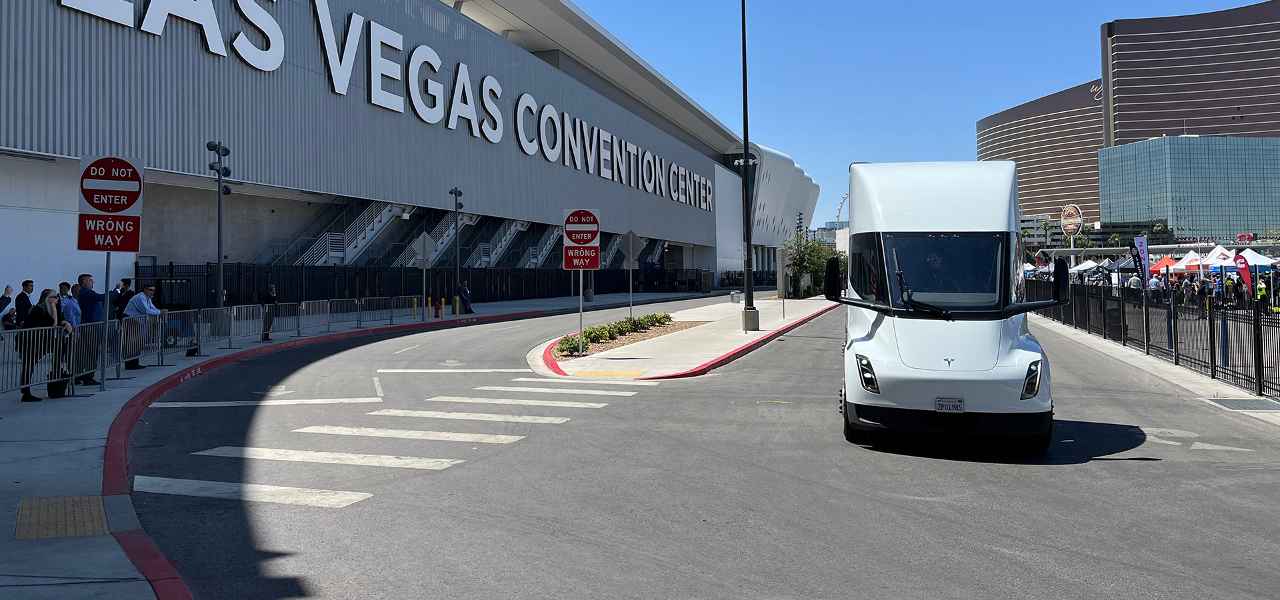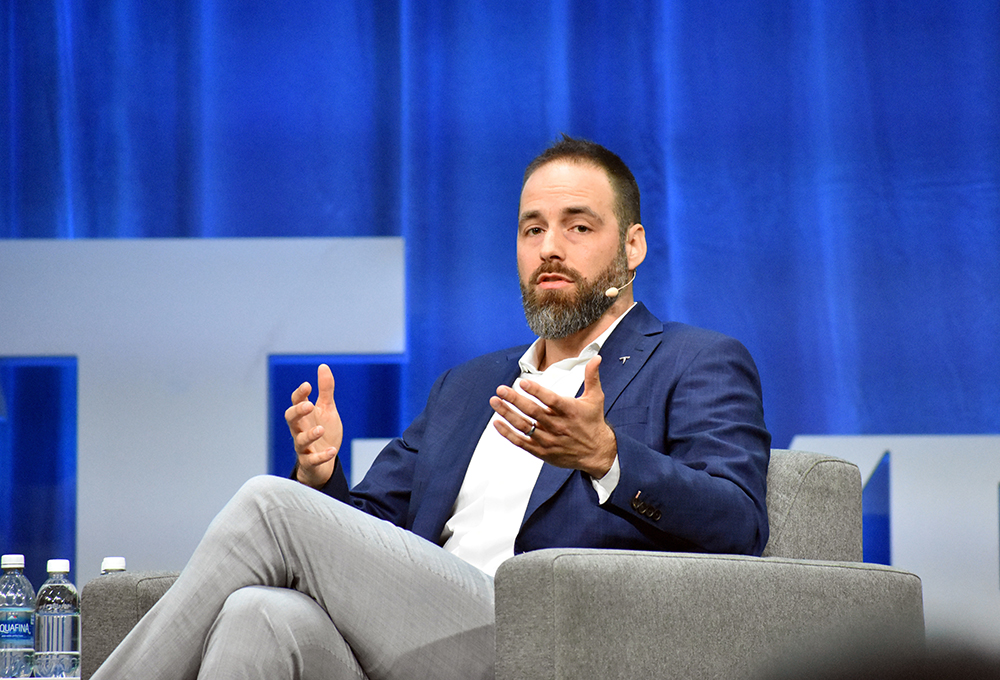 特斯拉Semi电动半挂卡车在2024年美国绿色交通及充电桩展(ACT Expo 2024)的试驾活动中亮相。(Ryan Gehm)
特斯拉Semi电动半挂卡车在2024年美国绿色交通及充电桩展(ACT Expo 2024)的试驾活动中亮相。(Ryan Gehm) 特斯拉 Semi 的 300 英里(480 公里)版本的皮重小于 20,000 磅(9070 kg),而长里程配置据说能够小于 23,000 磅(10,400 kg)。(RYAN GEHM)
特斯拉 Semi 的 300 英里(480 公里)版本的皮重小于 20,000 磅(9070 kg),而长里程配置据说能够小于 23,000 磅(10,400 kg)。(RYAN GEHM) 特斯拉的 Priestley 声称 Semi 比 SuperTruck 2 车辆更高效。肯沃斯在 ACT Expo 上展示了其 SuperTruck 2 演示车,该车的燃油效率高达 12.8 mpg。(RYAN GEHM)
特斯拉的 Priestley 声称 Semi 比 SuperTruck 2 车辆更高效。肯沃斯在 ACT Expo 上展示了其 SuperTruck 2 演示车,该车的燃油效率高达 12.8 mpg。(RYAN GEHM) 特斯拉 Semi 工程高级经理Dan Priestley强调,充电是特斯拉的核心业务,卡车业务也是如此。(RYAN GEHM)
特斯拉 Semi 工程高级经理Dan Priestley强调,充电是特斯拉的核心业务,卡车业务也是如此。(RYAN GEHM) 彼得比尔特公司的 Jason Skoog 强调,无论是充电还是氢燃料加注,都必须加快基础设施建设,才能发挥这些技术的潜力。(RYAN GEHM)
彼得比尔特公司的 Jason Skoog 强调,无论是充电还是氢燃料加注,都必须加快基础设施建设,才能发挥这些技术的潜力。(RYAN GEHM) 约翰迪尔的 944 X-Tier 混合动力轮式装载机在采石场每天工作 12 小时或更长时间,这种应用不适合使用电池供电。(约翰迪尔)
约翰迪尔的 944 X-Tier 混合动力轮式装载机在采石场每天工作 12 小时或更长时间,这种应用不适合使用电池供电。(约翰迪尔) 戴姆勒北美卡车公司总裁兼首席执行官 John O'Leary 表示,柴油技术的发展不容忽视。(RYAN GEHM)
戴姆勒北美卡车公司总裁兼首席执行官 John O'Leary 表示,柴油技术的发展不容忽视。(RYAN GEHM)
特斯拉高管称即将扩大其纯电动卡车的产量,同时其他行业专家也对其它脱碳途径发表了看法。
美国绿色交通及充电桩展(ACT Expo)通常在南加州举行,今年于5月20-23日在其东北方向265英里(425km)外的拉斯维加斯举办。有趣的是,大多数8级纯电动卡车的续航里程有限,甚至无法行驶完这段距离,尤其是在穿越丘陵地形或装载重物的情况下。
但是,有一辆纯电动卡车能够完成这段里程,它在满载(即总重8.2万磅)状态下最大续航里程预计可达到500英里(805 km)。这就是在ACT展上首次亮相的特斯拉Semi电动半挂卡车。特斯拉Semi的高级工程经理Dan Priestley在展会期间的一场主旨演讲中称:“只有像Semi这种在针对特定用途、从零开始专门设计的电动车平台上打造的卡车,才能够实现如此高的续航里程-质量比。车上毫无空间浪费,动力总成与车辆配合得天衣无缝。”
自2017年特斯拉 Semi项目推出以来就一直领导该项目的Priestley详细说明了特斯拉计划进行扩产的这款卡车“在现有技术条件下可实现的”空载质量。300英里(480 km)版Semi的空载质量最高可达2万磅(9070 kg),而长里程版的空载质量最高可达2.3万磅(10,400 kg)。
截至目前,特斯拉Semi半挂卡车已累计行驶了350万英里(560万km)。百事公司目前正使用该电动卡车运输饮料——Priestley还特别强调了运输饮料,不只是薯片。特斯拉在其自己的供应链运营中也在使用Semi半挂卡车,例如将电池组从内华达州的超级工厂运往加州弗里蒙特工厂。Priestley表示:“两年前,这条路线上的运输工作100%由柴油卡车完成,现在我们正在逐渐增加电动卡车的比例。”他指出,这条路线路况严峻,不仅需要经过I-80州际高速公路上的唐纳山口(Donner Pass),而且全年都会遭遇酷暑或严寒的恶劣天气。
作为参考,肯沃斯称其在ACT上展出的SuperTruck 2示范车较2009年推出的T660车型提高了136%的货运效率,最高可达12.8英里/加仑。
Priestley宣称:“该示范车队及其所有配套设施(包括基础设施和售后服务等)均表明我们已具备实施车队电动化的技术条件。是时候扩大电动卡车的生产规模了。”他表示特斯拉正在内华达州建设一座工厂,预计于2026年开始向客户大规模交付车辆,并逐步达到每年5万辆的最终产能目标。
下文摘录了行业专家针对燃油和驱动技术发表的一些独到见解。这些技术即便目前尚不成熟,未来也很可能在卡车和非道路领域实现脱碳目标的过程中发挥作用。
氢能——彼得比尔特(Peterbilt)的总经理Jason Skoog 表示:“如果要发展氢能,那么我们现在就必须建设更多基础设施。就像电影《Field of Dreams》中的一句台词——‘If you build it, we will come.’氢能可能是目前最理想的技术,氢燃料内燃机也颇具技术优势。但如不能补给燃料,那么氢能方案就不具备可行性。”
可再生燃料——西斯科(Sysco)首席供应链官Dan Purefoy表示:“我们在加州的运营中发现,80%的车队使用HVO(氢化植物油,也称为可再生柴油或绿色柴油)作为燃料。我们非常乐于尝试将这种可再生燃料推广到其他市场,但我们始终面临着一项挑战——加州以外地区的供应成本居高不下。如果HVO能够迅速增长,并在全国范围内进行推广,我们肯定会充分利用HVO推动公司业务发展。”
柴油——戴姆勒卡车北美公司总裁兼首席执行官John O’ Leary表示:“坦率地说,柴油业务正承受着各种压力。虽然我们非常乐于在未来进行再投资,但如果没有足够的利润支撑,我们也没有能力在未来进行再投资。”
Usually hosted in Southern California, the Advanced Clean Transportation (ACT) Expo moved about 265 miles (425 km) north and east for its latest edition, taking place in Las Vegas from May 20-23. Interestingly, that distance challenges the range limits of most Class 8 battery-electric trucks, particularly if traversing hilly terrain or hauling heavy loads.
One electric truck capable of covering such a stretch – with its estimated range of up to 500 miles (805 km) fully loaded at 82,000 lb GCW – is the Tesla Semi, which made its trade-show debut at the ACT Expo. “Achieving strong range-to-mass ratios is only possible with a dedicated, purpose-built, ground-up electric platform – exactly what the Semi is. There’s no wasted space, the powertrain and the vehicle work hand in hand,” Dan Priestley, senior manager of engineering for the Tesla Semi, said during a keynote in Las Vegas.
Priestley, who’s been leading the Tesla Semi program since the platform was announced in 2017, presented a slide showing the “attainable” tare weights for its planned high-volume production trucks “based on learnings we’ve had thus far.” The 300-mile (480-km) version of the Semi has an attainable tare weight of less than 20,000 lb (9070 kg) while the long-range configuration is capable of being less than 23,000 lb (10,400 kg).
Tesla Semis have accumulated 3.5 million miles (5.6 million km) to date. PepsiCo is using the electric trucks to haul beverages – not just chips, Priestley emphasized – and Tesla is running the Semi in its own supply chain operations – for example, hauling battery packs from its gigafactory in Nevada to support its Fremont, California, factory. “Two years ago, this route was one-hundred percent diesel. We are now electrifying it,” Priestley said. The route is challenging, he noted, passing through Donner Pass along I-80 and encountering both hot and cold weather conditions throughout the year.
“SuperTruck 2 [participants] are hitting their [freight efficiency] targets. Last year’s Tesla Semi fleet outpaced them. And if we load up the vehicle to max weight, we crush it even farther,” Priestley said. “Across the fleet, we’re seeing an average of 1.7 kWh per mile. Even in heavy-haul applications, we’re seeing less than 2 kWh per mile.”
For reference, Kenworth revealed its SuperTruck 2 at the ACT Expo, stating the demonstrator vehicle improved freight efficiency by up to 136% compared to its 2009 T660 model and achieved up to 12.8 mpg.
Priestley also stressed that charging is core to Tesla, and that goes for the trucking side of the business as well. “We’ve demonstrated that megawatt-level fast charging is available, reliable, safe and unlocks next-level economics,” Priestley said. “We have this deployed in the field today and are actively using it. What this does is it unlocks operational equivalence between diesel and electric. [Fleets] can swap one for one in operations.”
“This pilot fleet, and everything that goes along with it – infrastructure, servicing, etc. – has shown that we are technologically ready. Electrification can be done,” Priestley asserted. “Now it’s time for scaling.” Tesla is building a factory in Nevada that will begin higher-volume customer deliveries in 2026, he said, ramping to an eventual target capacity of 50,000 units per year.
Opining on future of propulsion
Battery-electric trucks were not the only topic of discussion at the ACT Expo. Following are a few additional compelling quotes from industry experts on fuels and propulsion technologies that likely will contribute to the decarbonization of trucking and off-highway sectors in the future – if not already.
Hydrogen – “If hydrogen is going to be a solution, then we’ve got to have more of that infrastructure done now. It’s almost like a Field of Dreams moment – ‘If you build it, we will come.’ It could be the best technology out there, and hydrogen ICE is really great but if you can’t fuel it, it’s not going to be an option,” said Jason Skoog, general manager at Peterbilt.
Hybridization – “There’s some areas where pure battery-electric may not be feasible, may not be ready in its current state, but hybridization will be a great solution in those situations,” said Grant Van Tine, product manager, electric vehicles, John Deere Construction. He referenced a 944 X-Tier hybrid-electric wheel loader that operates 12 hours/day or more in a quarry: “If we could even make it battery-electric – which we physically cannot package that many batteries in this machine – it would add another 54,000 pounds to [the 120,000-lb machine] and cost three to four times what it is today.”
Renewable fuel – “We looked at our operations in California, eighty percent of our fleet leverages HVOs [hydrotreated vegetable oils, also known as renewable diesel or green diesel],” said Dan Purefoy, chief supply chain officer, Sysco. “We would love to try to expand that into other markets. We’ve seen that to be a challenge so far – the cost is still heavy with supply outside of California. That is an area if it were able to take off and expand across the country, we would definitely take advantage of that.”
Diesel – “The diesel business is paying for all of this, quite honestly,” said John O’Leary, president and CEO at Daimler Truck North America. “We will gladly reinvest that into the future, but without that there’s no ability to reinvest in the future.”
等级
打分
- 2分
- 4分
- 6分
- 8分
- 10分
平均分
